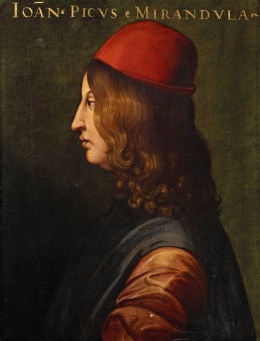Pico della Mirandola
ARTICLE UNDER CONSTRUCTION
Giovanni Pico della Mirandola (1463–94) is one of the best-known philosophers of the Renaissance: his Oration on the Dignity of Man is better known than any other philosophical text of the fifteenth century. Pico was also remarkably original—indeed, idiosyncratic. [1] Pico’s reverence for ancient wisdom drew him to the Florentine Platonic Academy established by Marsilio Ficino. His awareness of the universality of truth led him to reject such humanist tendencies as the emphasis upon oratorical style over philosophical reason and the exclusive dependence on ancient Greece for inspiration. Pico studied the mystical writings ascribed to Hermes Trismegistus, Zoroaster and Moses, Orpheus and Pythagoras, Christian theology, Islamic philosophy, and the Hebrew Qabalah. [2][3]
In 1486, at the age of 23, Pico published nine hundred theses which were to be freely debated by scholars and theologians all over Europe. Seven were condemned by Rome as heretical, and six others as 'dubious.' Included among the heresies were the propositions that (1) Origen, the Christian co-disciple of Plotinus under Ammonius Saccas and head of the Alexandrine Catechistic School, having been excommunicated for teaching reincarnation, should be thought to lie in heaven rather than hell, and (2) the science of magic and the Qabalah prove the divinity of the Christos. ref>Hesselink, Katinka. Pico della Mirandola http://www.katinkahesselink.net/his/PicoDellaMirandola.htm Accessed on 3/25/22</ref>
Early Years
Pico was born on February 24, 1463, to a noble Italian family, the counts of Mirandola and Concordia near Modena in the Emilia-Romagna north of Tuscany. [4] His father, Giovanni Francesco Pico, prince of the small territory of Mirandola, provided for his precocious son a thorough humanistic education at home. Pico then studied canon law at Bologna, leaving home at the age of fourteen, and Aristotelian philosophy at Padua and visited Florence and Paris, where he learned Italian, Latin, Greek, Hebrew, Aramaic, and Arabic. [5] [6] Pico's reverence for prisca theologia, ancient wisdom, drew him to the Florentine Platonic Academy established by Marsilio Ficino under the aegis and encouragement of Cosimo dei Medici. His awareness of the universality of truth led him to reject such humanist tendencies as the emphasis upon oratorical style over philosophical reason and the exclusive dependence on ancient Greece for inspiration. Pico studied Zoroaster and Moses, Orpheus and Pythagoras, Christian theology, Islamic philosophy, and the Hebrew Qabalah. Ficino translated Plato into Latin and Pico studied his works avidly. When agents of the Medicis brought the Hermetic writings to Florence, Pico urged Ficino to translate them, holding that they contained the root of wisdom and the synthesis of philosophy, science, and religion. Pico himself single-handedly brought the Qabalah into the heart of the Renaissance. [7]
In 1486, at the age of 23, Pico published nine hundred theses. He became the first Christian scholar to use Kabbalistic doctrine in support of Christian theology. [8] He planned to defend these theses that he had drawn from diverse Greek, Hebrew, Arabic, and Latin writers and invited scholars from all of Europe to Rome for a public disputation. For the occasion he composed his celebrated Oratio. A papal commission, however, denounced thirteen of the theses as heretical, and the assembly was prohibited by Pope Innocent VIII. Included among the heresies were the propositions that (1) Origen, the Christian co-disciple of Plotinus under Ammonius Saccas and head of the Alexandrine Catechistic School, having been excommunicated for teaching reincarnation, should be thought to lie in heaven rather than hell, (2) the science of magic and the Qabalah prove the divinity of the Christos. He prepared an opening address, Oratio de Hominis Dignitate, "On the Dignity of Man," but abandoned the project in the face of papal censure. [9]
According to Mme. Blavatsky he was a chela of the Masters:
For centuries the selection of Chelas — outside the hereditary group within the gon-pa (temple) — has been made by the Himalayan Mahatmas themselves from among the class — in Tibet, a considerable one as to number — of natural mystics. The only exceptions have been in the cases of Western men like Fludd, Thomas Vaughan, Paracelsus, Pico della Mirandola, Count de Saint-Germain, etc., whose temperamental affinity to this celestial science more or less forced the distant Adepts to come into personal relations with them, and enabled them to get such small (or large) proportion of the whole truth as was possible under their social surroundings.[10]
Online resources
Articles
- Pico Della Mirandola at KatinkaHesselink.net
Notes
- ↑ Stanford Encyclopedia of Philosophy. Giovanni Pico della Mirandola. Jun 3, 2008; revised May 15, 2020. https://plato.stanford.edu/entries/pico-della-mirandola/ Accessed on 3/25/22
- ↑ Hesselink, Katinka. Pico della Mirandola http://www.katinkahesselink.net/his/PicoDellaMirandola.htm Accessed on 3/25/22
- ↑ Encyclopedia.com. Pico della Mirandolla, Giovannihttps://www.encyclopedia.com/people/philosophy-and-religion/philosophy-biographies/giovanni-pico-della-mirandola Accessed on 3/25/22
- ↑ Stanford Encyclopedia of Philosophy. Giovanni Pico della Mirandola. Jun 3, 2008; revised May 15, 2020. https://plato.stanford.edu/entries/pico-della-mirandola/ Accessed on 3/25/22
- ↑ Britannica. Giovanni Pico della Mirandola, count di Concordia https://www.britannica.com/biography/Giovanni-Pico-della-Mirandola-conte-di-Concordia Accessed on 6/14/22
- ↑ Stanford Encyclopedia of Philosophy. Giovanni Pico della Mirandola. Jun 3, 2008; revised May 15, 2020. https://plato.stanford.edu/entries/pico-della-mirandola/ Accessed on 3/25/22
- ↑ Hesselink, Katinka. Pico della Mirandola. http://www.katinkahesselink.net/his/PicoDellaMirandola.htm# Accessed on 6/14/22
- ↑ Britannica. Giovanni Pico della Mirandola, count di Concordia https://www.britannica.com/biography/Giovanni-Pico-della-Mirandola-conte-di-Concordia Accessed on 6/14/22
- ↑ Hesselink, Katinka. Pico della Mirandola. http://www.katinkahesselink.net/his/PicoDellaMirandola.htm# Accessed on 6/14/22
- ↑ Helena Petrovna Blavatsky, Collected Writings Vol. IV (Wheaton, IL: Theosophical Publishing House, 1991), 607.
